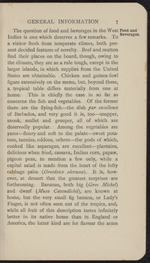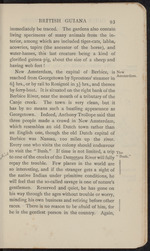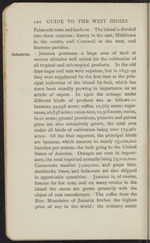| 1 |
 |
“...GENERAL INFORMATION
7
The question of food and beverages in the West Food and
Indies is one which deserves a few remarks. To Be76rages-
a visitor fresh from temperate climes, both pre-
sent decided features of novelty. Beef and mutton
find their places on the board, though, owing to
the climate, they are as a rule tough, except in the
larger islands, in which supplies from the United
States are obtainable. Chicken and guinea-fowl
figure extensively on the menu, but, beyond these,
a tropical table differs materially from one at
home. This is chiefly the case in so far as
concerns the fish and vegetables. Of the former
there are the flying-fish—the dish par excellence
of Barbados, and very good it is, too—snapper,
snook, mullet and grouper, all of which are
deservedly popular. Among the vegetables are
yams—floury and soft to the palate—sweet pota-
toes, tannias, eddoes, ochros—the pods of which,
cooked like asparagus, are excellent—plantains,
delicious when fried, cassava, Indian corn, papaw...”
|
|
| 2 |
 |
“...BRITISH GUIANA
93
immediately be traced. The gardens also contain
living specimens of many animals from the in-
terior, among which are included tiger-cats, labba,
acowries, tapirs (the ancestor of the horse), and
water-hasses, this last creature being a kind of
glorified guinea-pig, about the size of a sheep and
having web feet!
New Amsterdam, the capital of Berbice, is New
reached from Georgetown by Sprostons’ steamer in Arnsterdam-
6| hrs., or by rail to Rosignol in 3^ hrs., and thence
by ferry-boat. It is situated on the right bank of the
Berbice River, near the mouth of a tributary of the
Canje creek. The town is very clean, but it
has by no means such a bustling appearance as
Georgetown. Indeed, Anthony Trollope said that
three people made a crowd in New Amsterdam,
which resembles an old Dutch town rather than
an English one, though the old Dutch capital of
Berbice was Nassau, 100 miles up the river.
Every one who visits the colony should endeavour
^to visit the “ Bush.” If time is...”
|
|
| 3 |
 |
“...cultivation of
all tropical and sub-tropical products. In the old
days sugar and rum were supreme, but in 1893-94
they were supplanted for the first time as the prin-
cipal industries of the island by fruit, which has
since been steadily growing in importance as an
article of export. In 1906 the acreage under
different kinds of produce was as follows:—
bananas, 59,958 acres; coffee, 27,765 acres; sugar-
canes, 26,838 acres; cocoa-nuts, 10,318 acres; cocoa,
6021 acres; ground provisions, pimento and guinea
grass are also extensively grown, the total area
under all kinds of cultivation being over 774,961
acres. Of the fruit exported, the principal kinds
are bananas, which amount to nearly 15,000,000
bunches per annum, the bulk going to the United
States of America. Oranges are next in import-
ance, the total exported annually being 75,000,000.
Cocoa-nuts number 7,000,000, and grape fruit,
shaddocks, limes, and kola-nuts are also shipped
in appreciable quantities. Jamaica is, of course,
famous for...”
|
|
| 4 |
 |
“...Cathedral.
208 GUIDE TO THE WEST INDIES
two, 2S* 6d.; buggy for three, 4s.; Central Factory,
4s. and 6s.; Wallings Reservoir, 10s. and 14s.;
Fig Tree Hill, 12s. and 16s.; English Harbour;
14s. and 20s.
Cricket, tennis, rifle-shooting, and golf are the
chief amusements. There is a nine-hole golf
course near St. John’s, and good boating in
St. John’s and Parham Harbours, while capital
bathing can be indulged in near St. John’s, and,
indeed, all round the coast. Good sport with
deer, wild duck, guinea birds, and pigeons is to
be had in Barbuda (see above), off which island
tarpon fishing also gives good sport. A license
for deer costs j£i; and for other game, 10s.
The New Club, near Government House, “is
noted for its hospitality, and the principal London
papers and magazines can be seen at the Public
Library, which is situated in High Street, near
the landing-place.
The town of St. John’s, at the head of the
harbour of the same name, used to be defended
by Goat Hill Fort on the south, and...”
|
|
